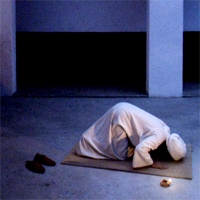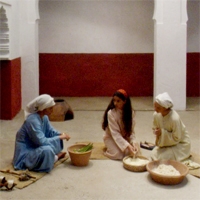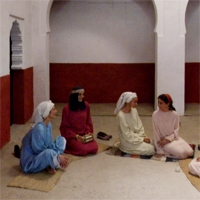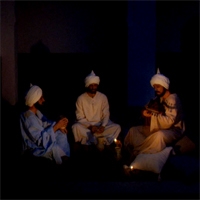The Islamic house consisted of a series of rooms built around a central, open patio. This design allowed for one or two (sometimes more) of the married sons to remain in the family home after marrying, reserving each area for conjugal intimacy within the building. The “extended family” that inhabited each house was a cohesive and autonomous group, their domestic work divided between the women.
This recreation of a typical workday in the life of an artisanal family in Madinat Balansiya provides an anthropological look at Andalusian society in the first few decades of the thirteenth century.
-
 Morning prayer
Morning prayerDaily prayer is a pillar of Islam. Five times a day, the muezzin calls the faithful to prayer from atop the minaret of the mosque. In the cities of al-Andalus were the largest mosques, where the community gathered for Friday’s midday prayer and to hear the jutba, or sermon, and the speeches by local neighborhoods, where regular daily prayers were held.
-
 The courtyard and the meal
The courtyard and the mealBread was the main food consumed by those in al-Àndalus, but the people also ate meat, fish, vegetables, and fruit. Asîda, a porridge consisting of wheat flower and fresh vegetables was a very common dish. Additionally, pureed lentils, beans, or chickpeas and yâshish, a vegetable soup consisting of fresh vegetables and wheat, were common dishes. These dishes were presented on ceramic platters placed on the floor or lowered tables. Couscous was introduced to al-Àndalus in the early thirteenth century.
In this scene, there is palatable tension between A'isha and his daughter-in-law Munà, reflecting the weaker position the latter holds in her family. Munà has still yet to conceive and knows that until her first child is born she will not bear the covetable position of being a “true” married woman.
-
 Wedding preparations
Wedding preparationsThe selection of a bride was an incredibly important task handled by a boy's parents. The husband's family often chose a bride within their immediate family in order to preserve the family's property and lineage. If the potential bride's family accepted the offer of the man's family, then the families negotiated a marriage agreement, known as a jitaba. The agreement set the date of the wedding, the dowry, and the composition of the trosseau as a sort of “price” for the bride, known as a sîdâq. Following the signing of the marriage agreement, a banquet was held at the husband’s house.
-
 Education and lineage
Education and lineageIn the al-Àndalus cities, it was common for children to receive an elementary education starting at a very young age. The schools were very basic, usually consisting of a miniscule shop where a teacher gathered his students and, in exchange for a salary, instructed the children in the memorization of the Quran and reading and writing, using physical punishment if necessary. Apart from one's academic education, children also received a paralell education at home in order to instill a sense of familiar pride and history. This was done through the memorization of one's family genealogy, which could almost always be traced back to Arab ancestors.
-
 An entertaining evening
An entertaining eveningVisits from relative and friends were a common social practice in al-Andalus that brought honor and prestige upon households. Visits were always guided by the principle of reciprocity, so families were happy to receive their relatives and friends. Evening visits to wealthier households were accompanied by musical instruments, song and dance performances by slaves, drinks, fruit, light chatter, jokes, and recitations of memorized verses. At the moment of the dramatization, Borriana has just fallen to the hands of Jaime I, and news of the christian advance could not help but work its way into the people’s conversations.
